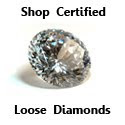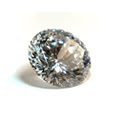One thing that never fails to amaze me is people's wrongly perceived ideas about a Diamonds weight vs what size it will be. Very few people seem to really know the actual size differences between say a 0.75 Ctw stone & a 1.00 Ctw Stone. Have a guess...................................
The actual approximate difference between the two sizes (using a Round Brilliant Cut Diamond as an example) is 0.7 mm, or 0.0275 inches! - who can honestly say that they could tell the difference without seeing both Diamonds up close and sat next to each other?
Something to consider is the fact that certain settings, if used correctly, can make a Diamond appear larger than it actually is. Then of course there's finger size..........it stands to reason that a 1.00 Ctw Diamond Ring will look considerably bigger when worn on a size 4 finger than it would on a size 8.
Some useful examples of Diamond weight vs. Diamond size
(Round Brilliant Cut):
0.25 Ctw - approximately 4.1 mm in diameter
0.33 Ctw - approximately 4.4 mm in diameter
0.50 Ctw - approximately 5.2 mm in diameter
0.75 Ctw - approximately 5.8 mm in diameter
1.00 Ctw - approximately 6.5 mm in diameter
If you want more info on this topic or any other posts, email me. I am always happy to help in any way that I can.










